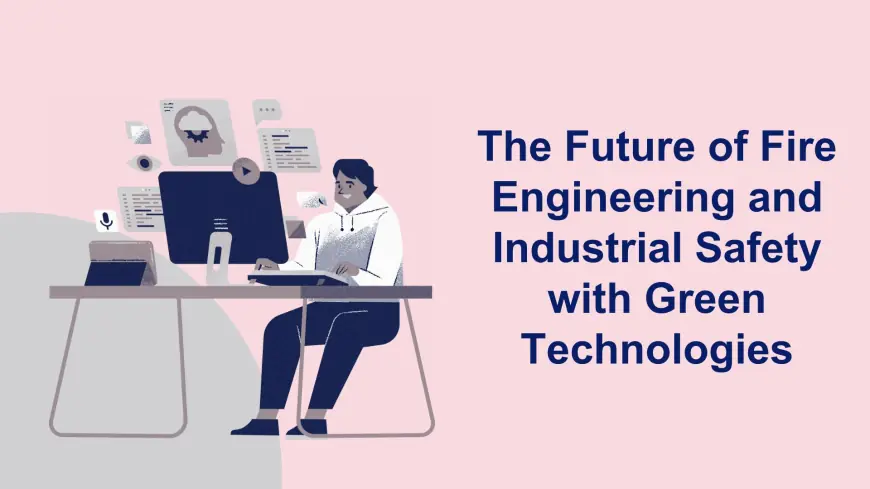The Future of Fire Engineering and Industrial Safety with Green Technologies
This article explores the future of fire engineering and industrial safety in the context of green technologies, emphasizing innovations

Introduction
The field of fire engineering and industrial safety is undergoing a transformative shift driven by the global push toward sustainability and environmental responsibility. As industries adopt greener technologies to reduce their carbon footprint, fire safety practices must also evolve to match the challenges and opportunities presented by these innovations. The integration of green technologies is not only reshaping how fire risks are assessed and managed but is also enhancing overall workplace safety, efficiency, and resilience.
This article explores the future of fire engineering and industrial safety in the context of green technologies, emphasizing innovations, trends, and the critical role of sustainable practices.
The Rise of Green Technologies in Industry
Green technologies—also known as clean or sustainable technologies—aim to minimize environmental impact while enhancing operational efficiency. These include:
-
Renewable energy systems (solar, wind, hydro)
-
Electric vehicles (EVs)
-
Energy-efficient buildings
-
Sustainable materials and waste management
-
Smart technologies and automation
Industries worldwide are rapidly transitioning to such systems to meet regulatory demands, reduce costs, and demonstrate corporate social responsibility. However, with these advancements come new fire hazards and safety considerations that demand equally modern approaches in fire engineering.
Emerging Fire Risks with Green Technologies
While green technologies promote environmental benefits, they also introduce unfamiliar fire risks. Some of the prominent concerns include:
1. Lithium-Ion Batteries
Used widely in electric vehicles, renewable energy storage, and consumer electronics, lithium-ion batteries are highly efficient but pose serious fire hazards. Thermal runaway—a chain reaction leading to fires or explosions—can be triggered by overheating, overcharging, or physical damage.
2. Hydrogen Fuel Cells
Hydrogen is a clean fuel, but its high flammability and the invisible nature of its flame require specialized detection and suppression systems.
3. Photovoltaic (Solar) Systems
Solar panels may continue to generate electricity even when disconnected from the main grid, complicating fire suppression during emergencies.
4. Biomass and Biofuel Facilities
These eco-friendly alternatives to fossil fuels are still combustible and can create dust explosions or uncontrolled fires if not properly managed.
Innovations in Fire Engineering for Sustainable Safety
To keep pace with the evolving landscape, fire engineering is embracing cutting-edge solutions that align with green principles:
1. Eco-Friendly Fire Suppression Systems
Traditional suppression systems often rely on chemical agents that harm the environment. Today’s systems prioritize:
-
Water mist systems: Use less water while effectively suppressing fire.
-
Inert gases: Such as nitrogen and argon, which are non-toxic and environmentally safe.
-
Clean agents: Like Novec 1230 and FM-200, which have low global warming potential.
2. Fire-Safe Design in Green Buildings
Modern architecture integrates passive fire safety measures into the design of green buildings:
-
Fire-resistant sustainable materials (e.g., treated bamboo, eco-concrete)
-
Smart ventilation and compartmentation
-
Fire modeling software to simulate risk in green building layouts
3. IoT and AI for Fire Detection
Smart sensors, AI-driven analytics, and Internet of Things (IoT) networks are revolutionizing fire detection and response:
-
Real-time monitoring of battery packs or high-risk zones
-
Predictive maintenance alerts to prevent ignition sources
-
Automated alarms and suppression activation in milliseconds
4. Advanced Training and Simulation Tools
Virtual reality (VR) and augmented reality (AR) are being used to train safety officers and emergency responders in dealing with green tech-specific hazards.
Regulatory and Compliance Considerations
As green technologies proliferate, national and international regulatory bodies are updating fire safety codes to incorporate new risks and mitigation standards. These include:
-
National Fire Protection Association (NFPA) standards for energy storage systems
-
ISO guidelines on hydrogen safety and clean agent systems
-
Bureau of Indian Standards (BIS) codes for sustainable construction and electrical safety
Compliance not only protects assets and lives but also ensures operational continuity and avoids legal repercussions.
Role of Fire Engineers and Safety Professionals in a Green Future
Fire engineers and industrial safety officers will play a pivotal role in:
-
Risk assessment and hazard identification specific to new technologies
-
Designing and implementing fire safety systems aligned with sustainability goals
-
Ensuring worker safety through ongoing education and awareness programs
-
Coordinating with environmental engineers to integrate safety in eco-friendly projects
Their role is expanding from traditional response-based models to proactive involvement in product design, infrastructure planning, and sustainability strategy.
Challenges in Adopting Green Fire Safety Practices
Despite the advantages, the adoption of green fire engineering solutions faces several challenges:
-
High initial costs of eco-friendly suppression systems and monitoring technologies
-
Knowledge gaps regarding new materials and emerging risks
-
Lack of standardized protocols across industries for green fire safety
-
Resistance to change from traditional safety practices
These challenges can be addressed through policy support, industry training, and public-private collaborations.
The Way Forward: Building a Sustainable and Safe Industrial Future
The integration of green technologies in fire engineering and industrial safety is not just a trend—it is an essential part of future-proofing industrial development. Organizations that invest in sustainable safety practices will benefit from:
-
Improved risk management and insurance compliance
-
Enhanced brand reputation and investor confidence
-
Reduced environmental impact and operational costs
-
A safer, healthier workplace for all
Educational institutions and safety training academies must also evolve their curricula to incorporate green safety modules, equipping the next generation of professionals with the skills required to navigate this changing landscape.
Explore courses now at AIFSE - All India Fire & Safety Engineering to find the right fit for your future in Fire Engineering and Industrial Safety!
Conclusion
The convergence of green technologies and fire safety represents a critical frontier for industrial progress. As we move toward a cleaner and more sustainable future, fire engineering and industrial safety must keep pace through innovation, regulation, and education.
The future lies in designing safety not as an afterthought but as an integrated part of sustainable development. By embracing green fire safety technologies and practices, industries can ensure a balance between environmental stewardship, operational efficiency, and human safety.
What's Your Reaction?
 Like
0
Like
0
 Dislike
0
Dislike
0
 Love
0
Love
0
 Funny
0
Funny
0
 Angry
0
Angry
0
 Sad
0
Sad
0
 Wow
0
Wow
0

















































